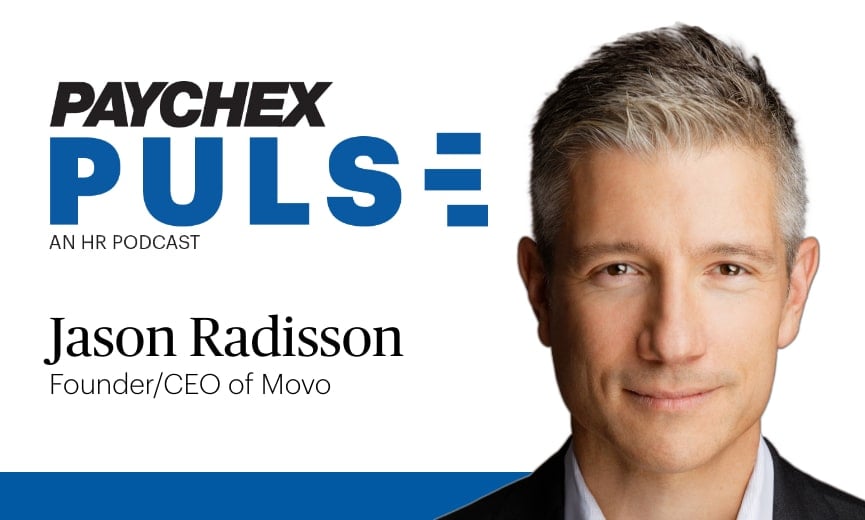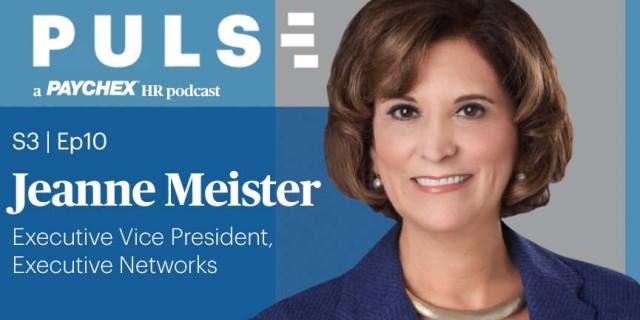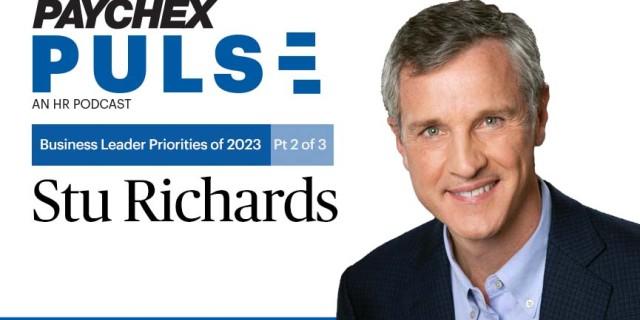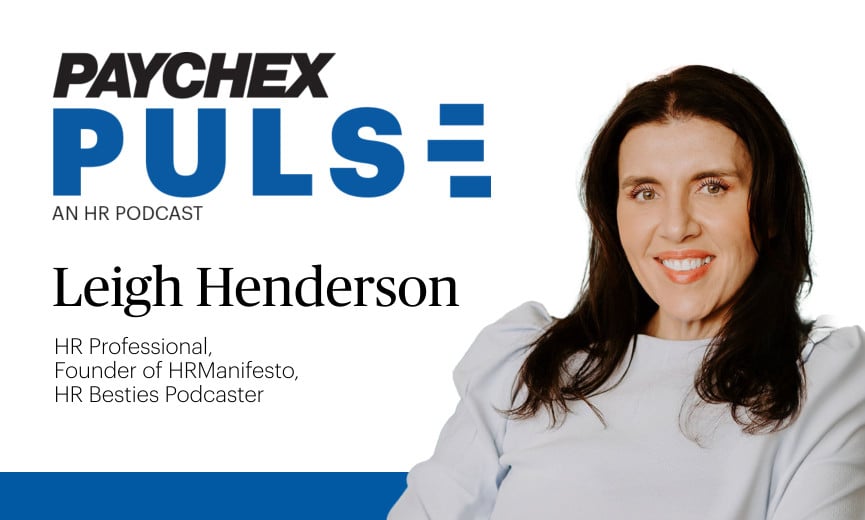Retirement Rewritten: Unpacking SECURE 2.0 with a Compliance Expert
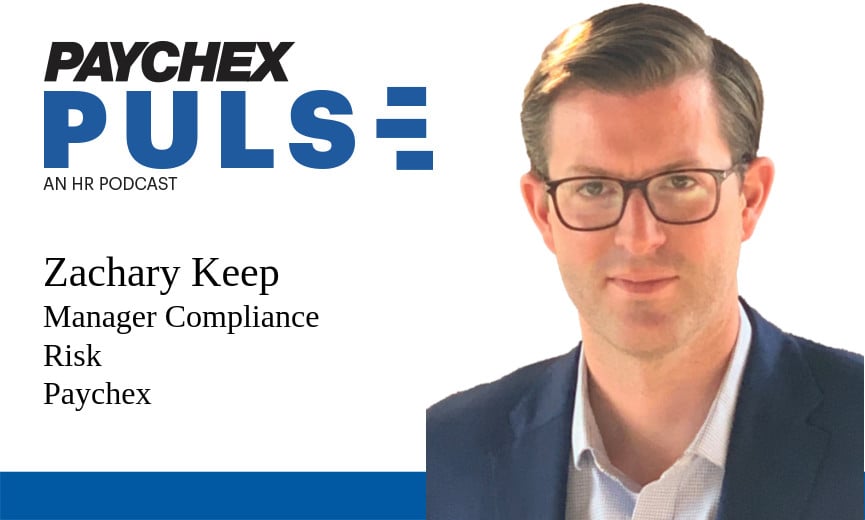
Podcast •

Watch
Summary
On this episode of PULSE, we dive into the game-changing legislation that is the SECURE Act 2.0. Compliance Risk Manager Zachary Keep shares many of the groundbreaking provisions included in SECURE 2.0 and their potential impact on employers, employees, and HR professionals. With its automatic enrollment provision, student loan matching, and other sweeping changes, SECURE is set to redefine the retirement landscape for years to come.
Topics include:
00:00 – Welcome Zachary Keep
01:16 – Overview of SECURE Act 2.0 provisions
03:41 – The impact of SECURE 2.0 on employees
06:05 – The benefits of offering a 401(k)s
07:49 – SECURE’s student loan matching provision
09:56 – New employer tax credits
14:06 – HR administration of SECURE 2.0 provisions
14:46 – New rules for hardship distributions
16:47 – Changes to catch-up provisions
17:36 – Retirement benefits for part-time employees
18:26 – The impact of automatic enrollment on retirement
20:01 – Establishment of a retirement “lost and found”
20:54 – The benefits of pooled employee plans
22:46 – What to expect next from SECURE 2.0
24:54 – Wrap up
We've got answers for all your FAQs on SECURE 2.0.
Learn more about the incentives SECURE 2.0 offers to businesses and employees.
What’s happening in your state? Check out your state mandated retirement programs.
From enrollment to plan maintenance, Paychex can help you tackle SECURE 2.0 by taking care of all of your retirement plan details.
See how the SECURE Act can boost your tax savings. Try our tax credit estimator.
View Transcript
Zachary Keep (00:01)
And for those who aren't aware, many states say, "Look, employer, you must offer a retirement plan for the benefit of your employees," and that usually takes the form of an IRA or an individual retirement account. Often, it's state-run. Well, the employer who is kind of left with that choice, well, there is no choice. You must establish the plan.
Rob Parsons (00:27)
Welcome to Season 4 of Paychex PULSE, an HR podcast where HR professionals can find great insights on today's top issues and be inspired to build and lead effective teams in a healthier workplace.
Rob Parsons (00:42)
Hi, everyone. Welcome to Paychex PULSE. I'm Rob Parsons. Today, we're going to be talking about retirement, specifically SECURE Act 2.0. Joining me is one of our very own compliance experts, Zach Keep. Zach has been involved in the retirement industry for 15 years and he has extensive experience navigating compliance issues for both 403(b) and 401(k) plans. Zach, welcome to the show.
Zachary Keep (01:10)
Rob, thank you so much. It's great to be here.
Rob Parsons (01:12)
It's excellent, and this is really a great topic, and it's a big topic. I know SECURE Act 2.0 covers a ton of ground. Can you just give me some highlights, just some overviews what, you know, our listening audience really needs to know about this act?
Zachary Keep (01:26)
Yeah, absolutely, and you say SECURE 2.0, but I think it's important to remember that SECURE 1.0, back in 2019, would still be a very big story if it weren't for 2.0 coming along. It's almost easier to think about what isn't impacted when it comes to retirement. These are jointly, these are two just sweeping pieces of legislation, that it's almost, that it's not an understatement to say that it rewrites retirement plans in America. But when we look at SECURE 2, which passed in the waning days of 2022, industry is still assimilating its impact, you know, it changes things on a couple of levels. There's some very highly visible changes, some additions, some alterations, and a lot of ink has been spilled over these things. You know, the big one that springs to mind is matching contributions on student loans, which maybe we can talk about in a little bit. Automatic enrollment, making 401(k)s an opt-out as opposed to an opt-in arrangement, something that over the next decade is going to profoundly alter the landscape of retirement plans in America. These are the big changes. Everyone's heard about them, but what's almost a little bit more interesting, I think, are some of the little changes that, you know, you maybe don't see on the news, and there's been, you know, many, many news articles, as you know about all of this, but things like changes to the RMD age, that's going to affect all of us eventually, things like changes to the way hardships are processed, the creation of some new and very nuanced distribution types that maybe won't affect everyone, but for the people who need them are going to be a major relief, a major help. So SECURE 2.0 changes the big stuff, and it changes the little stuff all at once. And then, as if all of that's not enough, there are some things that might change, and we're waiting to figure out how, and you're going to hear me come back to this a lot, but we're still waiting on a lot of guidance from regulatory agencies about just how some of these things that SECURE 2 changes are going to work, so, very exciting time right now.
Rob Parsons (03:41)
Yeah, I imagine it's got to be interesting for HR professionals, because they can get ahead of this in some ways but certainly not in others, but that when they're thinking about this, there's got to be a lot of things to think about with participants, with my employees, and what I have to get them ready for, educate them on, because employees probably are not watching SECURE Act 2.0 news.
Zachary Keep (04:03)
Yeah, and I think it makes sense for the average employee to maybe kind of gloss over this a little bit, but you're exactly right. This is going to change things for employees, maybe not as much as it's going to change things for employers. You know, the average employee might not need to think about SECURE 2 as much as maybe an HR professional would. But yes, there's going to be changes, and I think for an employee, they're all good changes. It is much easier to participate than it's ever been, thanks to SECURE 2.0, and there's a host of new benefits. Now, I know in the interest of time, I probably won't be able to go through them all, but I think the real benefit is there's a lot more flexibility in 401(k)s than there was before SECURE 2, and even before SECURE 1. SECURE 2 gives the employee a little bit of facilitated access to a 401(k) plan. You know, it's a little bit easier in an emergency, in a hardship situation. It's going to be a little bit easier for that employee to get some funds, a little bit easier for the HR professional too. We can touch on that. But the employee has more access. There are certain populations that have historically needed to access a 401(k) and maybe some roadblocks were thrown up. You know, the big one that I spend a lot of time talking about right now here at Paychex is helping employees who have been the victim of a domestic violence situation. SECURE 2 enables them to get money out of that plan in an emergency. Huge benefit for those folks who need it, but something almost no one talks about. Bottom line, though, what SECURE 2 does is it incentivizes participation and it gives the employee options that the employees never really had before.
Rob Parsons (05:47)
I think that's so great, because one of the scary things, maybe even a deterrent to a 401(k) plan in the past was that money was put away, I could never see it again until I was well, well along in my career.
Zachary Keep (06:00)
Right.
Rob Parsons (06:01)
And what if I needed it? It became very difficult, so I'm really glad to hear that. We also know a 401(k) plan is a great tool for attracting talent, for retaining talent. I just got an article shared with me today, that according to the National Bureau of Economic Research, people are willing to forego 3.4% of their wages just to access a 401(k), and another 1.6% to get the employer match. Like, it's really valuable, as an HR professional, how do I convince my employer, how do I convince the principals, we should start this, we should be doing this?
Zachary Keep (06:37)
Right, right, and, you know, I would struggle to cite statistics off the top of my head, but I think we all know that especially in the small and medium-sized business world, maybe not everybody offers a 401(k). So, when you say, how do I convince, if I'm the HR person, how do I convince the boss man to offer that 401(k)? Well, you hit the nail on the head. The first story to tell is employee retention, without a doubt. You know, 401(k) in America, unless you're in the nonprofit world, maybe, or if you still have a pension, I've been told they're still out there, lurking somewhere, but 401(k) equates to retirement.
Rob Parsons (07:18)
Yes.
Zachary Keep (07:19)
So, in the eyes of that highly skilled employee who has other options elsewhere, a 401(k) is retirement, full stop. So just offering that retirement plan is going to help retain that employee. It's going to help attract that employee. So, the first story to tell is retention. And to circle back to SECURE 2.0, I think, you know, the retention attractiveness of a 401(k) is a little bit higher. And the one provision of SECURE 2.0 that springs to mind is student loan matching.
Rob Parsons (07:54)
Yes.
Zachary Keep (07:55)
You know, it's probably the provision that's seen the most ink spilled. There's a lot of questions about just how it's going to work. It's definitely coming and it's coming in the very near future. But, you know, in layman's terms, what this provision does is it allows an employer to match, we all know 401(k)s have a match, usually, starting at around 3%. You know, employee puts dollars in, employer matches up to a certain limit. Well, SECURE 2.0 kind of combines the two crises that we hear about on the evening news when it comes to this provision. We hear about student loans, we hear about retirement. SECURE 2 sticks them together, because now an employer looking to maybe retain those highly skilled employees, can say, "Hey, you know, we know you might have a lot of student loans. When you contribute to your student loans, we are going to treat those repayments, your student loan repayments are going to be treated as elective deferrals for purposes of matching." In other words, "We're going to pretend those student loan repayments actually went into your 401(k) plan."
Rob Parsons (09:04)
Okay.
Zachary Keep (09:05)
"And we're going to match on them." Now, lots of questions about just how this is going to work and I think the 401(k) industry as a whole is collectively holding its breath. We're waiting on that guidance. But I do think, just, if only because of the press that it's gotten, that's the kind of thing that an employer could look to when it comes to retaining employees.
Rob Parsons (09:28)
Think about how awesome that is. If you were younger, 23, 24, 25…
Zachary Keep (09:30)
Absolutely.
Rob Parsons (09:32)
…you don't have a lot of disposable income.
Zachary Keep (09:33)
Precisely.
Rob Parsons (09:34)
You're not going to save for 60 years down the road. Now all of a sudden, there's a retirement building up for you…
Zachary Keep (09:41)
Waiting.
Rob Parsons (09:41)
…while you're doing, making the payments you have to make.
Zachary Keep (09:45)
And of course, we all know the earlier the contributions get in, the more time they have to grow. We've all seen the magic of compounding before.
Rob Parsons (09:50)
Yes, yes.
Zachary Keep (09:52)
So, yeah, I think it's going to be very interesting to see the direction that goes in. But let me go back to your original question, if I may, you know, how do I as the HR person make the case that we should be doing this, we should be offering this 401(k)? Well, retention. But if that doesn't work, SECURE 2 gives that HR person another story to tell, and that story is a little bit more black and white, and that's tax credits. SECURE 1, way back in 2019, you know, before COVID overshadowed everything, SECURE 2 was a big, I'm sorry, SECURE 1.0 was a big story, because it incentivized employers to establish a plan. It offered some tax credits for what we would call startup costs. And SECURE 1.0, years back, started out saying, "Hey, employer, 50% of your startup costs, depending on your size and a few other factors, 50% of your startup costs you can claim as a tax credit." SECURE 2 went much further. In today's world, if a employer has less than 50 employees, 100% of startup costs are available as a tax credit. There's a cap on that. I believe it's $5,000.
Rob Parsons (11:07)
But how attainable is that now?
Zachary Keep (11:09)
Very attainable. It's very, very attainable. And, you know, you can work with your record-keeper, your 401(k) providers, and they should be able to help you. You know, they're not your accountant, but they can help you claim those tax credits when the time comes. So right off the bat, there's an incentive. And I should also note that if you are a larger employer, if anybody listening to this has maybe 52 employees, you're not left in the cold. The SECURE 1.0 paradigm still applies for you. You've still got that 50% tax credit. So, there's an incentive to establish. The other thing that's very interesting with SECURE 2, you know, I remember as myself and everyone else in the 401(k) industry was reading through the text of SECURE 2.0 as kind of the Christmas music was playing in the background in 2022, I was kind of surprised to see there was another tax credit. You know, we expected an expansion of the startup tax credit. There was also a employer match tax credit, and what this does is it allows an employer to claim tax credit, up to $1,000 per employee, for matching contributions, those matching contributions we just talked about, the 3% that we all probably know and love. Very interesting. I think what Uncle Sam wanted to do was encourage particularly the small and medium folks to start that plan, and when they started it, not just offer a bare-bones plan, but to offer a rich plan…
Rob Parsons (12:42)
Right.
Zachary Keep (12:43)
…to offer a plan that's going to help employees, because now it helps the employer to do that. So, you know, taken together, the retention piece, the tax credit piece, you know, these tax credits aren't forever, unfortunately, but they are very lucrative right off the bat, and I think we've seen already, just in the conversations I've had, you know, this has really incentivized employers to establish that 401(k) plan, particularly, here's the last piece of the puzzle, particularly if you're in about the 50% of states that have a state-level mandate. And for those who aren't aware, many states say, "Look, employer, you must offer a retirement plan for the benefit of your employees." and that usually takes the form of an IRA or an individual retirement account. Often, it's state-run. Well, the employer who is kind of left with that choice, well, there is no choice. You must establish the plan, depending on the state that you're in, but you can choose what type of plan. You could choose that IRA, or you could choose that now newly flexible, newly enriched 401(k). You know, there's a lot of folks in the industry who would argue the 401(k) is a better vehicle, and I think SECURE 2 only adds weight to that argument.
Rob Parsons (14:00)
That's fantastic, and it's so interesting how those dynamics are changing. What happens to me as the HR pro now? I've got the plan in place, or I have a retirement plan in place. What's changing that I have to react to on an admin level? Because it's not going to run itself.
Zachary Keep (14:19)
No, it's not. Of course, there's always somebody like a Paychex who can help.
Rob Parsons (14:23)
Well, yes, yes.
Zachary Keep (14:24)
But, you know, for the HR professional, I think SECURE 2, administratively speaking, is a mixed bag. SECURE 2 as a whole is great, it does great things, but from the day-to-day standpoint of how much paperwork do you have to get done, SECURE 2 helps you, I think, in many ways. Right off the top of my head, you know, hardship distributions, we touched on that earlier. Historically, a hardship distribution required a little bit of work, required employee and employer to kind of work together. Employer as the plan sponsor, historically with a standalone plan, would need to make sure that the employee actually needed a hardship distribution. How did they know? Well, conveniently, the IRS defines a set of six criteria, pretty dire stuff, you know, prevention of eviction, medical bills, you know, post-secondary education costs, things like that. Employer would often need to go as far as looking at the bill, making sure that the amount of the hardship did not exceed the financial need. I can see why the legislation was drafted that way.
Rob Parsons (15:33)
Right.
Zachary Keep (15:33)
You know, I can see the thinking behind that: "We wanna keep people from using a 401(k) like an ATM. That's not what it's for." It's still not what it's for. But SECURE 2 kind of allowed the reliance upon participant representation. I think that's a huge benefit for that HR person who now no longer needs to have that maybe very awkward conversation…
Rob Parsons (15:56)
Yeah, right.
Zachary Keep (15:57)
…with an employee. And, you know, I've heard a lot of those awkward conversations over the years. You know, "I want a hardship for utility payments." "Well, that's not one of the circumstances defined by Uncle Sam, I'm sorry." No longer. You know, employee now certifies, "Do I meet the requirements? Yes or no?" So, a little bit of work off the plate. I think some other things might kind of fill that empty spot on the plate. The one that springs to mind, again, student loan payments. For those plans who offer, and it's not a mandatory provision, there's going to be some degree of administrative work involved with that. What that looks like, we just don't know yet. I think other changes will maybe not be as heavy an administrative burden, but they're going to be something that a HR pro wants to be aware of. There's some changes to the catch-up provisions, creation of new catch-up provisions, which is great. Everybody, particularly those in the 60 to 63 age range, very excited to contribute, I believe, it's up to $10,000 more. But for certain employees, employees who make over $145,000 a year, there's what's called the Rothification of catch-ups. In other words, if you make more than that 145K, your catch-up contributions by default must be Roth.
Rob Parsons (17:19)
So, your post-tax contribution. Okay.
Zachary Keep (17:21)
Exactly, exactly. Your catch-up. So, your basic limit, you can choose as you always have, but if you're maybe over the age of 50, your catch-up contributions are now taking place on a Roth basis. So, the HR pro's going to need to be aware of that. I think there'll also be some work when it comes to tracking what we call long-term part-time employees, employees who maybe haven't met the traditional threshold for eligibility for a 401(k) plan. SECURE 2 kind of enables those employees, or maybe around 500 hours a year, for, you know, two years at a time, they're now eligible. You know, someone's going to need to keep an eye on that, whether that's the employer or an outfit like a Paychex.
Rob Parsons (18:09)
It's so great that that's accessible to an employee like that, because there is loyalty, that is a kind of relationship, and I think, in the past, we've unfairly denied them full access to some of the benefits. It would be appropriate. Just because their situation's different, doesn't make them any less valuable.
Zachary Keep (18:26)
And I think the other part of that story, when you talk about access, I'd mentioned in passing automatic enrollment. You know, in 10 years, I think this is what we still might be talking about with SECURE 2.0. Historically, if you wanted a 401(k) plan, you had to do work, you had to proactively take steps to enroll, right? Well, for new plans, you know, that's very soon going to change. Doesn't affect existing plans today, but for that plan that's established, you know, three years from now, new plan, maybe new business, there is, well, again, not necessarily a new business, just new plans. I don't want to get too in the weeds of the text of SECURE 2.0. But basically, for soon-to-be established plans, the paradigm is going to become one of default participation. Employee starts in the 401(k) and needs to take action to get out, and I think, historically, a lot of employees just weren't aware. I mean, obviously there's notices, but sometimes those notices don't get read, sometimes those notices don't get understood, sometimes the employee realizes what a great option a 401(k) is and maybe they just never get around to filling out the paperwork. Well, automatic enrollment is going to change all of that. Now if the employee wants out, that's where action needs to happen, otherwise they are enrolled more or less right from the beginning.
Rob Parsons (19:58)
They're accidentally saving for their own future.
Zachary Keep (20:00)
Precisely, precisely. And incidentally, I know I've probably gone far into the weeds here, but SECURE 2.0 is also going to establish what we're calling a retirement lost and found. So down the line, again, how it's going to work, the industry just doesn't know yet, but there is going to be a government database of some kind that will enable that employee who maybe was automatically enrolled 25 years ago, well, they're going to be able to go and find that plan maybe once they've forgotten about it, and hopefully, the market will do well and they're going to find that it's full of an unexpected nest egg.
Rob Parsons (20:34)
Wouldn't that be great?
Zachary Keep (20:35)
It would be. I would take it, for sure, for sure.
Rob Parsons (20:39)
A couple last things I want to touch on, a couple things you've mentioned. One was, you talked about SECURE 1.0 had a lot. This is 2.0 now. You talked about some of the provisions of 1.0. Is there anything else in 1.0 that HR professionals and business leaders should be aware of?
Zachary Keep (20:54)
Yeah, you bet. You know, I think the big story with SECURE 1.0 was the establishment of what's called a pooled employer plan, or a PEP. And a pooled employer plan from a compliance standpoint, of course, that's my background, compliance, is very, very interesting, because it enables a group of employers to, as the name implies, kind of pool themselves together. They're an aggregate plan. So, you're no longer just a small business with, say, 10 employees with your standalone plan. You are now part of, you know, there are some very large PEPs out there, you're part of a plan that has, you know, thousands, hundreds of thousands of participants. You're benefiting from that better pricing. And what's very interesting under a pooled employer plan is, you have, another acronym, what we're calling a pooled plan provider. I've heard it called a P3, which I think is great. That pooled plan provider runs the plan. They bear the fiduciary responsibility for the plan. Paychex, of course, offers a pooled employer plan. I believe we have one of the largest in the country. As a compliance guy, that fiduciary part is a little bit scary to me, but for the HR professional, you know, that work goes off the plate, that risk goes off the plate. So, while me and my folks in the compliance department might no longer sleep at night, the plan, well, the HR pro is going to be able to sleep a little bit better at night with a pooled employer plan. Is it the right fit for everybody? Maybe, maybe not. But it is a very interesting option that I think has really, really taken off since SECURE 1.
Rob Parsons (22:39)
That's really interesting, because you don't think about new retirement products.
Zachary Keep (22:45)
Yeah.
Rob Parsons (22:46)
The other thing you've mentioned, and you've said this a few times, this is coming, that's coming. In three years, this'll happen. In 10 years, we're going to see this.
Zachary Keep (22:46)
Yeah.
Rob Parsons (22:46)
What's going on there?
Zachary Keep (22:56)
You know, a couple of different things. Some of the provisions of SECURE 2 were effective right away, things like the tax credits. Other things are, you know, starting in 2024, starting in 2025, and down the line. So, some things aren't effective right now. Other things, you know, there's a couple of different levels to how something like SECURE 2.0 becomes incarnate. You know, there's the text as passed by Congress. Great, but that doesn't, it tells us what we need to do but it doesn't necessarily tell us how we need to do that. So, for that we wait on regulatory guidance from DOL, from IRS. So, when I've alluded to the industry is just waiting to see, what we're waiting to see is how the plan sponsor makes, for example, the Rothification of catch-up contributions work. Okay, we know we need to do it, but how?
Rob Parsons (23:59)
Right.
Zachary Keep (24:00)
You know, tell us, you know, what is going to get us thrown in jail, what is not going to get us thrown in jail. I exaggerate, but maybe not that much. Those things are going to need to be decided. Student loans, I think, is going to be a big one. That retirement lost and found that I mentioned, we know that it's coming. We know that it's a great tool. Conceptually, no one can argue with it. But the question is, how? How does an employer transmit that data? Where do they send it? What data do they need to send? How often? When? All of that is going to be spelled out by the regulations when they come, and that's going to be, you know, months and years before we have all of those answers. So, I often joke with my people that SECURE 2 is going to keep us in business for at least a few more years, so we're doing good.
Rob Parsons (24:49)
I was just thinking the same thing, Zach. You're going to be very busy over the next few years.
Zachary Keep (24:53)
Yeah, I think so. Definitely.
Rob Parsons (24:54)
Well, thank you so much for being on the podcast today. This was really just awesome information.
Zachary Keep (24:59)
Yeah, it was my pleasure. I'd love to come back.
Rob Parsons (25:01)
Thank you so much. And thank you to our listeners for joining as well. If you want to learn more about retirement, about PEP plans, about SECURE 2.0, just go to paychex.com. Check out the Knowledge Center. We've got articles, webinars, and even information on Paychex plans that you can look into. So, thank you once again for joining, and as always, please stay happy and healthy. Be sure to subscribe to this and our Paychex THRIVE Business Podcast on your favorite podcast platform. Looking for more ways to keep your finger on the pulse of industry dynamics? Visit our resource center for the latest research, thought leadership, and news, at paychex.com/worx. That's W-O-R-X. Thanks again for joining us. Until next time, please stay happy and healthy.

 Apple Podcast
Apple Podcast Spotify
Spotify iHeartRadio
iHeartRadio
